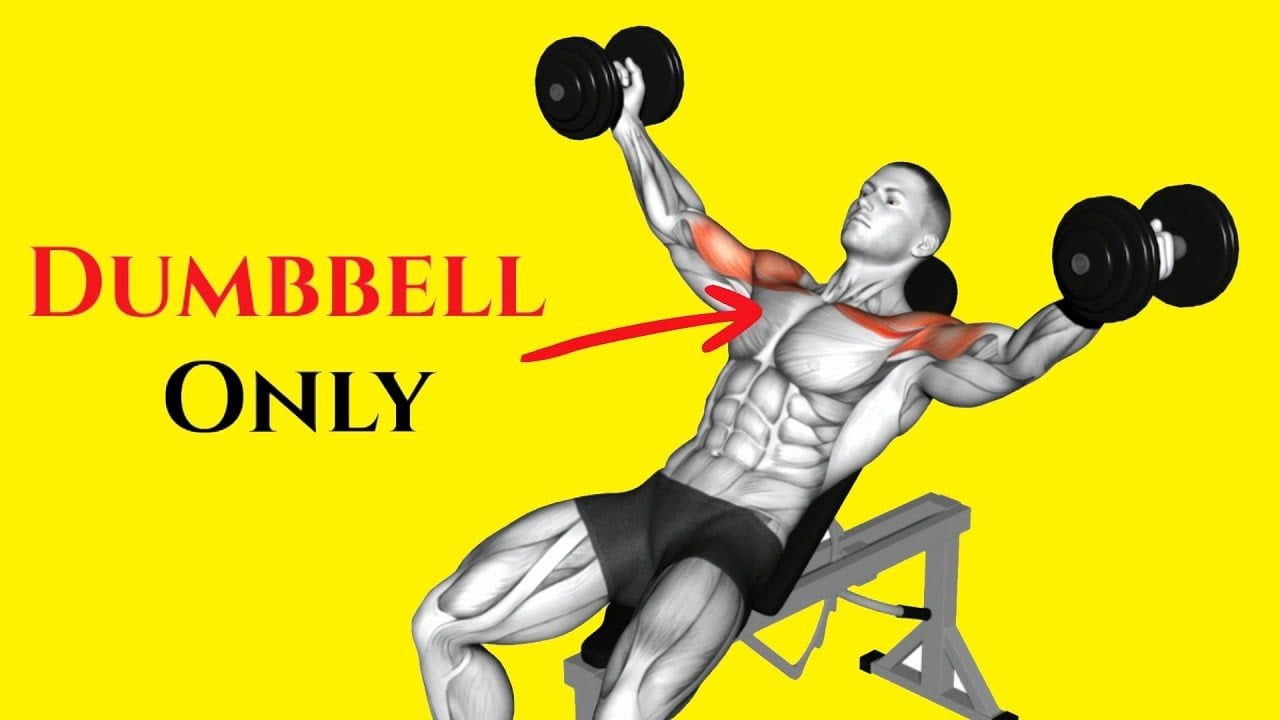Training your upper chest is important to building a perfect chest shape. You must then add dumbbell exercises to your chest workout routine.
It helps you create that coveted full, rounded chest appearance and improves your shoulders’ strength and stability.
The upper chest is notoriously difficult to develop, but with the right exercises and techniques, it is possible to build them.
Let’s dive into the science behind upper chest development, the best exercises, tips for proper form, and learn how to tailor your training.
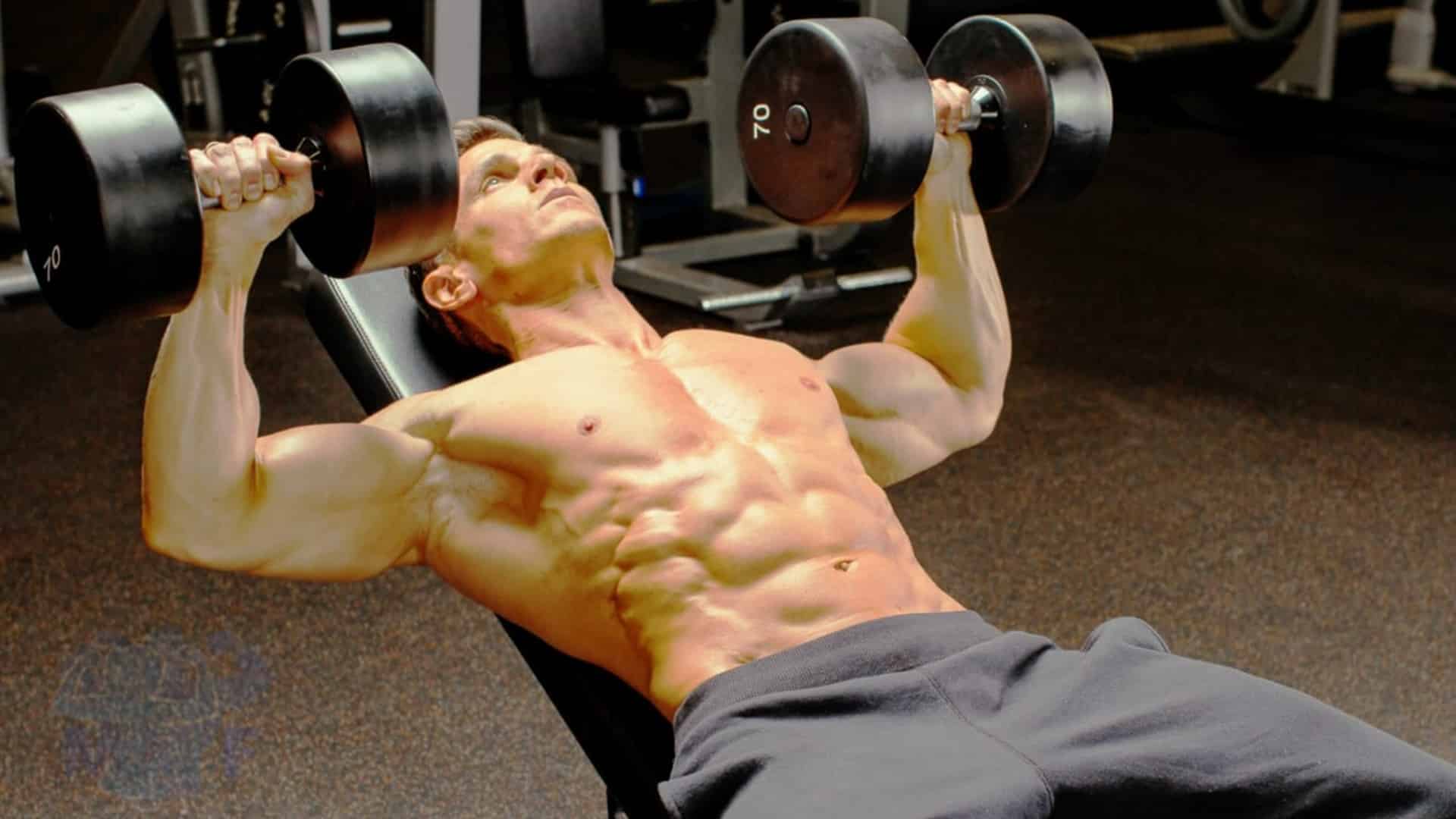
- How To Train Upper Chest With Dumbbell
- 1. Pressing Position
- 2. Grip Position
- 10 Upper Chest Exercises With Dumbbells
- 1. Incline Dumbbell Press
- 2. Alternating Incline Dumbbell Bench Press
- 3. Dumbbell Incline Around the World
- 4. Incline Reverse Grip Dumbbell Press
- 5. Incline Dumbbell Fly
- 6. Dumbbell Incline Press on Exercise Ball
- 7. Incline Dumbbell Twist Fly
- 8. Dumbbell Incline One-Arm Fly
- 9. Incline Bench Dumbbell Pullover
- 10. Standing Upward Chest Fly
- Upper Chest Training Tips And Workout Routines
- 1. Sets and Reps For Upper Chest Workout Routine
- 2. Workout Routine
- 3. Upper Chest Dumbbell Exercises
- 4. Advanced Techniques
- FAQ
- Can I do upper chest exercises with dumbbells?
- Is the upper chest difficult to build?
- How do you target a top chest?
- References
How To Train Upper Chest With Dumbbell
If you want to develop the upper chest to get more defined pecs, it is best to read this whole blog. Here, I will show you how to effectively improve the visual appearance of this portion of the chest muscle.
The chest muscle is commonly known as the pectoralis (pecs) muscle. The pectoralis major has two functional subdivisions –the upper and lower regions.
- The upper region is referred to as the sternoclavicular head because of its attachment to the clavicle.
- The lower regions are sometimes called the sternocostal head because of their attachment to the ribs.
Here’s a twist: you can’t completely isolate the upper chest. Every chest exercise you do will work your entire chest. However, certain exercises emphasize the upper portion more than others.
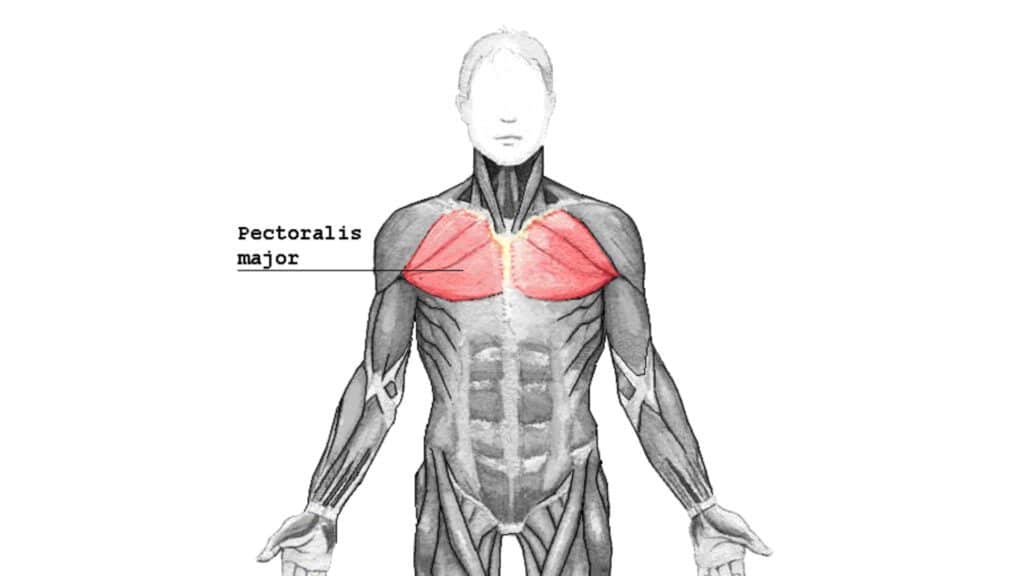
Here are some key tips for effective upper chest training.
1. Pressing Position
The pectoral muscles work differently depending on the angle at which you bring your arm forward.
- The upper chest muscle fibers are the target of Incline pressing.
- The lower chest muscle fibers are the target of decline pressing.
- It is possible to target your complete chest muscle with a flat pressing.
An incline bench press will work the upper chest more than a flat or decline bench press. If you want to increase the stimulation of the upper chest, you should aim for an angle of at least 30 degrees.
The study found that the most activity for the upper part of the pectoralis major muscle occurred when the bench was angled at 30 degrees.
At a zero-degree bench inclination (flat bench), the middle and lower parts of the pectoralis major muscle displayed higher electrical activity.
If you go beyond 30 degrees, you will transfer the emphasis from your upper chest to your front delts.
2. Grip Position
Change your grip from overhand to underhanded has a profound effect on upper chest muscle activation. Changing your grip can increase upper chest activation by up to 30%.
A group of Canadian scientists found that the muscle activity of the upper pecs in weight-trained subjects performing reverse-grip bench presses was more than 30% greater than when they did standard-grip bench presses.
The reverse-grip bench press is one of the best exercises you can do to build the upper chest.
One of the most important things you can do if you want to build a bigger upper chest with dumbbells is to remember to not just focus on compound exercises but also need to focus on isolation exercises.
10 Upper Chest Exercises With Dumbbells
Here is the list of the best upper chest dumbbell workouts, which help train the chest at various angles, strengthen it, and build a well-developed chest.
1. Incline Dumbbell Press
If you’re looking for straightforward dumbbell upper chest exercises to add to your routine, the Incline dumbbell press is a great staple exercise to get you started.
Just like the Inline bench press, the Inline dumbbell press works mostly on the upper pecs. However, dumbbells allow a full range of motion and are, therefore, in some ways better than the bench press. They add an extra range of motion at the top for complete chest development.
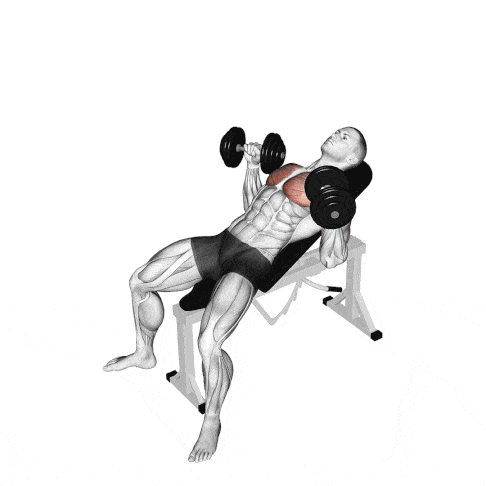
How To Do
- Adjust the bench to an incline position, typically between 30 and 45 degrees.
- Lie on the bench with a dumbbell in each hand, resting them on your thighs.
- Press the dumbbells upwards until your arms are fully extended. Keep the motion controlled and avoid locking your elbows at the top.
- Feel a good chest squeeze at the top.
- Lower the dumbbells and feel a good chest muscle stretch at the bottom.
- Do 3–4 sets of 8–12 reps for muscle growth
Tips
- Adjust the bench to an incline of about 30 to 45 degrees. A steeper angle targets the shoulders more, so find the sweet spot that best targets your upper chest.
- To protect your shoulder joints, keep your elbows slightly tucked in (around 45 degrees from your body).
- If you’re lifting heavy weights, consider having a spotter help you position the dumbbells and provide assistance if needed.
2. Alternating Incline Dumbbell Bench Press
The dumbbell incline alternate press builds size and strength in your chest, specifically targeting the upper chest. You might think this is just a chest exercise, but your core works overtime to keep you stable.
Since each arm gets a brief rest while the other works, you might find you can pump out a few extra reps.
The alternating press also helps to improve muscle activation, stability, and coordination.
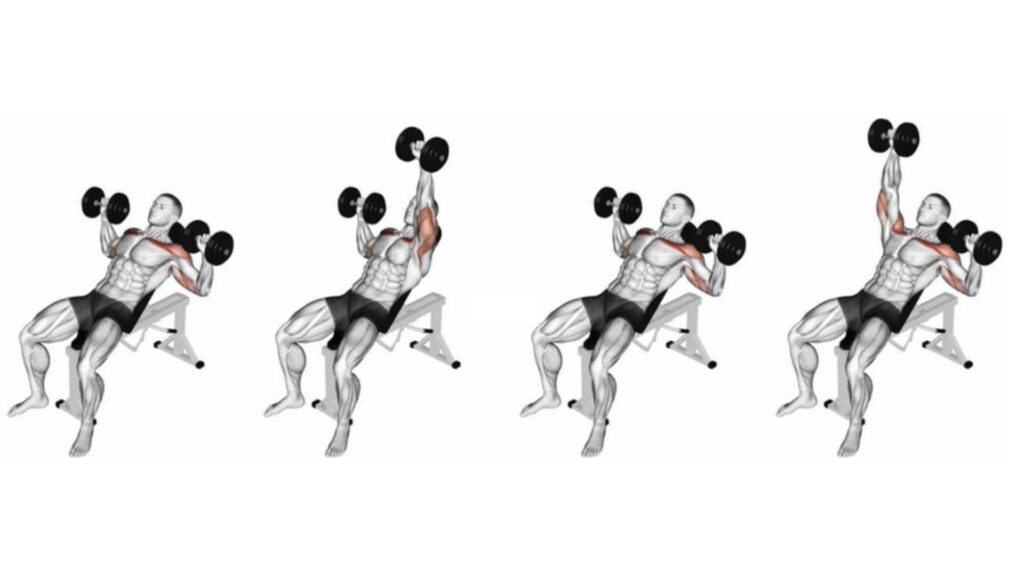
How To Do
- Grab a pair of dumbbells, and lie on an incline bench (30-45 degrees inclined).
- Hold a pair of dumbbells directly above your chest with your arms fully extended and your palms facing outward.
- Pull your shoulder blades together and stick out your chest, then lower both dumbbells to the sides of your chest.
- Now, press one dumbbell upwards while keeping the other dumbbell at your side.
- Then, as you lower the dumbbell, press the other one upward.
- Maintain a steady, controlled rhythm, alternating arms with each rep.
Tips
- Make sure to utilize a full range of motion throughout the exercise.
- Maintain a firm foot placement on the ground to stabilize your body and support the lift.
- Ensure both sides of your body are working equally to prevent developing any muscle imbalances.
3. Dumbbell Incline Around the World
The dumbbell incline around the world is a complex movement that engages multiple muscle groups and joints.
This advanced exercise works the upper chest and shoulders while challenging your core stability and shoulder mobility.
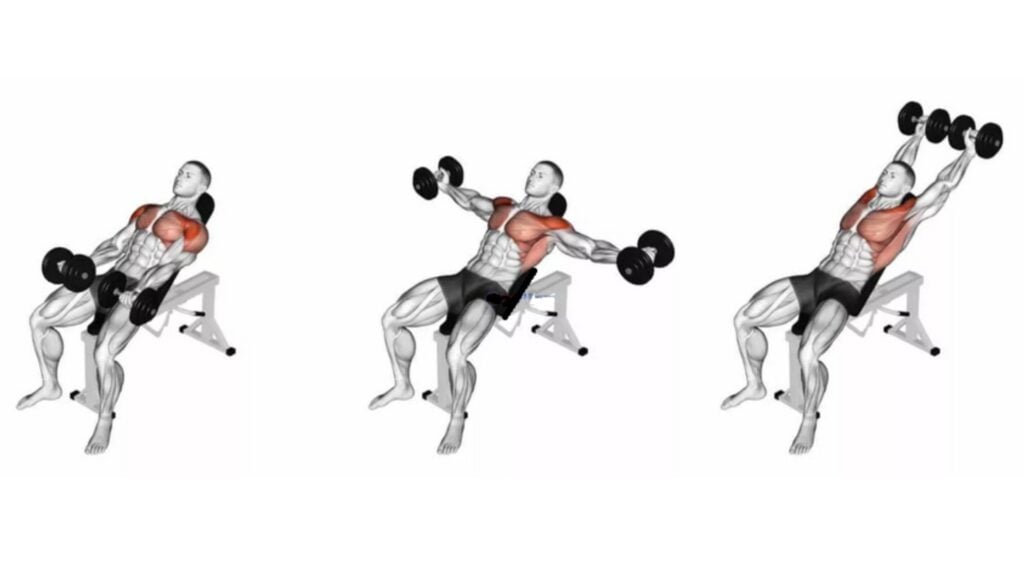
How To Do
- Set an incline bench to about a 30-45 degree angle.
- Choose a pair of light to moderate dumbbells. This exercise is more about control and form than heavy lifting.
- Grab a dumbbell in each hand and lie on the bench with your feet flat on the floor.
- Place the dumbbell on the thigh and create a semicircle by rotating them up over your head.
- All the movement should happen with the arms parallel to the bench at all times.
- As the dumbbells reach the top of the circle, reverse the motion.
Tips
- Perform press in a controlled manner.
- Ensure your range of motion is comfortable and controlled. Don’t overstretch your arms beyond your natural flexibility.
4. Incline Reverse Grip Dumbbell Press
The reverse-grip bench press is a variation of the traditional bench press. In it, you use an underhand grip (palms facing you).
It is a compound exercise that simultaneously works for multiple muscle groups. In addition to targeting the upper chest, incline reverse grip bench presses also train the triceps, anterior deltoids, and serratus anterior.
This is helpful for athletes who want to improve their bench press strength or other physical abilities.
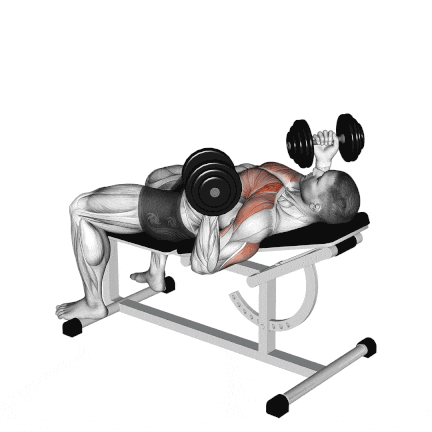
How To Do
- Grab a pair of dumbbells, and lie on an incline bench (30-45 degree inclined).
- Extend the dumbbell above your chest.
- Keep your elbow slightly bent, lower the weight down until it is about chest level and hold.
- Bring your arm back toward the midline of your body and focus on using your upper pec muscles to draw them back together.
- Repeat for the desired number of reps.
5. Incline Dumbbell Fly
The Incline dumbbell chest fly is a strength training exercise in which the hand and arm move through an arc while the elbow is kept at a constant angle.
The Incline chest fly, a bodybuilding favorite, is an isolation exercise and is usually performed after big compound lifts, like the bench and incline press. It is considered the perfect finishing move and a great way to focus on your chest after many pressing exercises.
Do not only do a Flat chest fly, but also add an incline bench position because the incline bench position isolates the harder-to-develop upper pectorals.
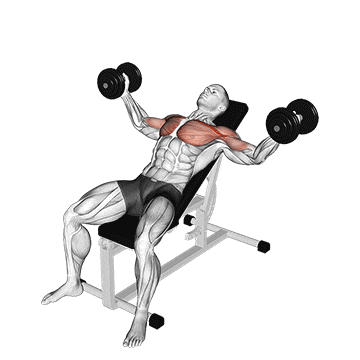
How To Do
- Set an incline bench at a 30-to 45-degree angle. Lie on the bench with your feet flat on the floor.
- Lift your arms straight up from your shoulders and the dumbbells directly over your upper chest.
- Slowly lower your arms to your sides until your wrists reach about shoulder level or slightly above.
- Bring your arms back toward the midline of your body, and focus on using your pec muscles to draw them back together.
Tips
- Maintain control. With a 4-second descent, slight pause, contract with a reverse motion, hold, and repeat.
- Pick a weight that you can control, that’s not too light or too heavy — find what’s right for you.
- Maintain tension in your abs and don’t allow your lower back to excessively arch.
6. Dumbbell Incline Press on Exercise Ball
If you want to try new exercises for your upper chest with dumbbells, try doing the Incline Press with a dumbbell on a ball.
It is a variation of the incline dumbbell bench press and an exercise used to build the muscles of the chest. The shoulders and triceps will be indirectly involved as well.
Using a stability ball instead of an inclined bench adds instability to the exercise, which forces the recruitment of many stabilizer muscles, especially in your core.
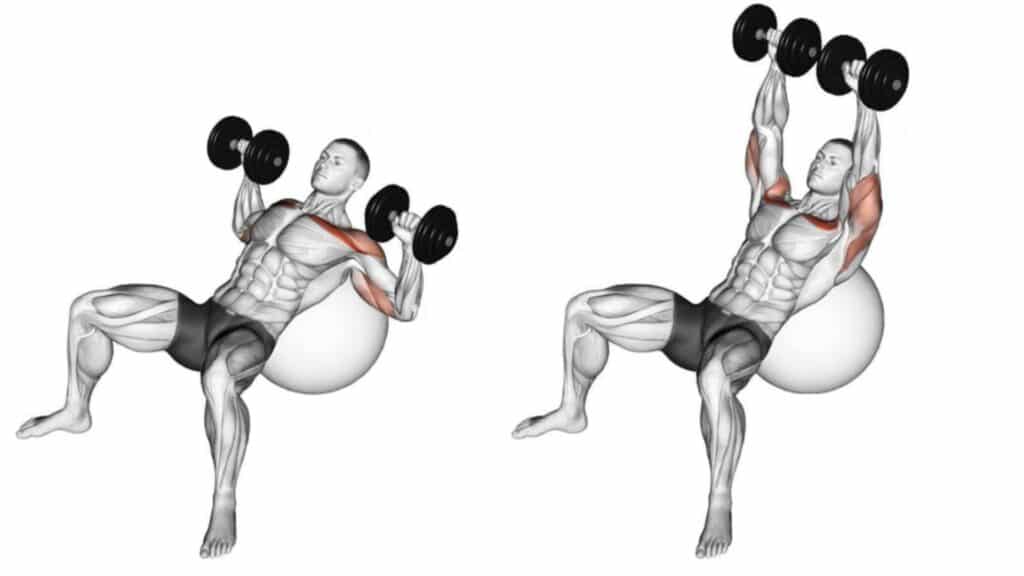
How To Do
- Grab a pair of dumbbells and sit down on a Swiss ball.
- Slowly step forward until your torso forms a 45-degree angle to the ground.
- The Swiss ball will be positioned under your upper back and shoulders.
- Raise dumbbells until they are straight above your chin with your arms straight.
- Lower the dumbbells until they are just outside your upper chest.
- Pause, then push the dumbbells straight back up to the starting position as quickly as possible. This completes one rep.
Tips
- Be sure to keep core tight and feet planted into the ground to keep balance and strengthen the core.
- Exhale as you push the weight up, and inhale as you lower the weight down.
- Lower weight down until upper arms are just past parallel to the ground.
7. Incline Dumbbell Twist Fly
The Incline dumbbell twist fly is a slight variation of the incline dumbbell fly to train the upper chest.
The incline used in an incline dumbbell twist fly helps you better isolate the muscles of the upper chest, and the contraction produced by twisting the weight is greater than one typically experiences from the traditional incline dumbbell fly.
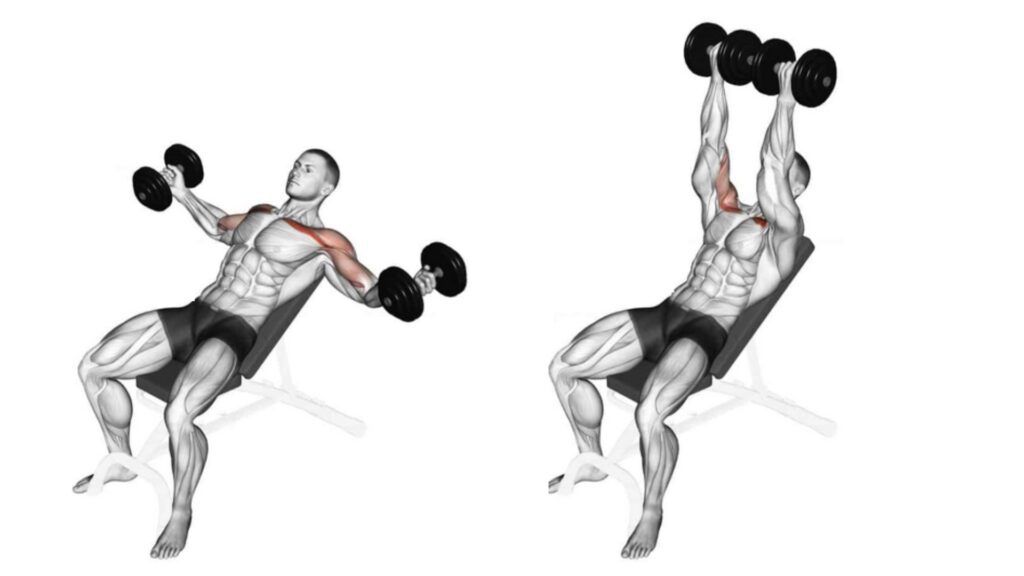
How To Do
- Grab a dumbbell in each hand with a neutral grip and lie on an incline bench.
- Hold the weights above you at shoulder height.
- Slightly retract your shoulder blades, unlock your elbows, and slowly lower the dumbbells laterally while maintaining the angle at your elbow.
- Once the dumbbells reach chest level, reverse the movement by squeezing your pecs together.
- As the dumbbells return to the starting position, twist the handles so that the bottom of the dumbbells almost touch.
- Without allowing the dumbbells to touch, start the next repetition by untwisting the handles back to a neutral position, and continue until the set is completed.
Tips
- Imagine you’re trying to hug a tree while completing the exercise.
- Avoid touching or banging the dumbbells together at the top of each repetition to keep constant tension.
8. Dumbbell Incline One-Arm Fly
When doing an upper chest workout with a dumbbell, you can add plenty of single-arm exercises to correct potential imbalances.
The Dumbbell Incline one arm fly is a unilateral variation of the incline dumbbell fly. This exercise is best used on upper hypertrophy days or chest workouts in more traditional bodybuilding splits.
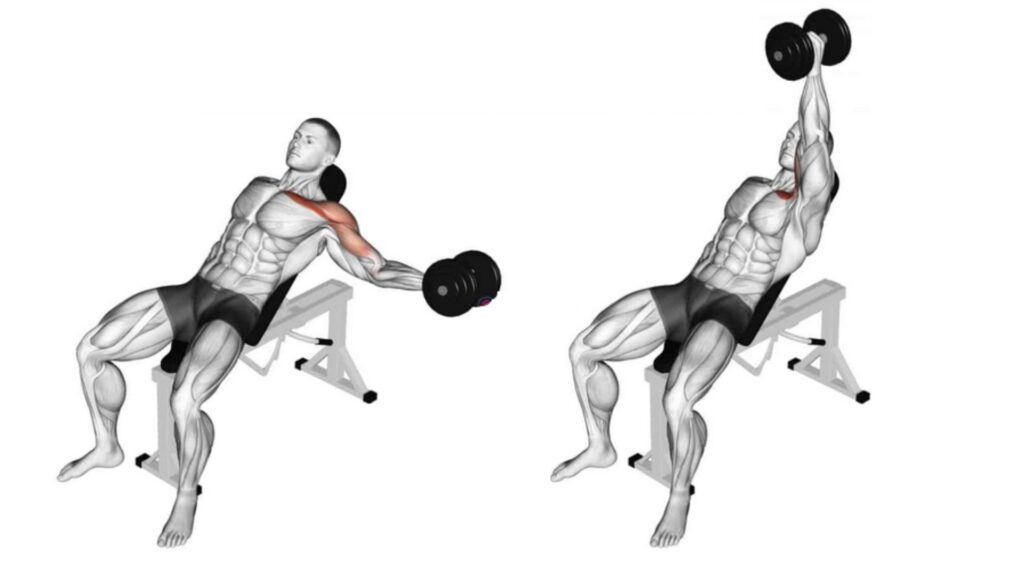
How To Do
- Grab a pair of dumbbells, and lie on an incline bench (30-45 degree inclined).
- Extend the dumbbell above your chest. Keep your elbow slightly bent.
- Lower the weight down until it is about chest level, and hold.
- Bring your arm back to the midline of your body and use your upper pec muscles to draw them together.
9. Incline Bench Dumbbell Pullover
Incline bench dumbbell pullovers are the best exercise to build a strong rib cage and build serratus anterior muscle to build a chest and back.
It allows for a wide range of motion, thus providing a deep pectorals and lats stretch.

How To Do
- Set the bench position between 30-45 degrees. Now lie across on an Incline bench.
- Grasp a dumbbell with both hands and get it straight over your chest.
- Lower the dumbbell in an arc slowly, getting a good stretch in your rib cage.
- Lower the dumbbell as far as possible, and then raise it back to the starting position.
Tips
- Maximum stretching ensures the greatest expansion of the rib cage.
- Vary the position of the bench to hit different angles of the upper chest.
10. Standing Upward Chest Fly
Standing with a dumbbell chest fly is a good exercise for targeting your upper chest. With only a pair of dumbbells, you can make your chest area broader and more developed.
This exercise is like a front raise that you would do for your shoulders, but with a simple twist of the wrists that makes it an effective chest exercise. For this one, you will require a dumbbell in each hand.
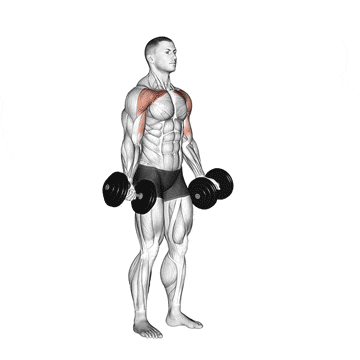
How To Do
- In a standing position, hold a dumbbell in each hand with your palms facing upward.
- Ensure your feet are shoulder-width apart and your arms down straight in front of your centre.
- Extend your arms up and out to the sides, keeping your elbows straight and your arms at chest level.
- Bring them back to the center to finish a single rep.
Tips
- Exhale during the concentric (muscle-shortening) part of the motion.
- Your arms and shoulders will work, but most of the work should be done with the pecs.
Upper Chest Training Tips And Workout Routines
1. Sets and Reps For Upper Chest Workout Routine
Of course, the number of sets and reps will be determined based on your fitness journey, but here is a great starting point:
Sets
According to the latest scientific evidence, 12–20 weekly sets per muscle group may optimize muscle growth.
- Beginners: ~10 sets per week.
- Intermediate: ~15 sets per week.
- Advanced: ~20 sets per week.
When a certain amount of volume stops being effective and your progress stalls, you can add sets to increase volume and use that as a driver of renewed progress.
Reps
The best rep ranges and loads to work with.
- For muscle endurance: Aim for 15-20+ reps, with a moderate amount of resistance.
- For muscle strength: 6-10 reps, with a heavier amount of resistance.
- For muscle hypertrophy (increased muscle size): Aim for 3-4 sets of 8-12 reps, with a moderate to heavy amount of resistance.
It is always best to start with a lower number of reps and sets, and then gradually increase as your strength improves
2. Workout Routine
If you’re new to lifting weights, don’t worry. This beginner-friendly chest workout routine is a great place to start.
When this gets easy, choose a heavier free weight. After you’ve upped your weight several times and feel strong in the movements below, move on to the intermediate routine. Until then, you can follow this beginner chest workout plan.
| Exercise | Sets | Reps | Rest |
|---|---|---|---|
| Incline Dumbbell Press | 4 | 8-12 | 60-90 sec |
| Incline Dumbbell Fly | 4 | 8-10 | 60-90 sec |
| Incline Dumbbell Pullover | 3 | 8-10 | 60-90 sec |
3. Upper Chest Dumbbell Exercises
4. Advanced Techniques
To strengthen your upper chest, you should try increasing the intensity of your workout. Drop sets, forced reps, and the pause-and-go method are some methods for intensifying your workouts.
However, with dumbbells, you can easily increase the intensity of your workout on your own. For example, if you want to do drop sets on the barbell bench press, you’ll need a partner to drop the weight from the barbell.
If you’d like to drop sets with dumbbells, you can easily do so by picking up lighter dumbbells.
FAQ
Can I do upper chest exercises with dumbbells?
You can do the same exercises for your upper chest with dumbbells as you do with a barbell. Above, I have provided some of our favorites, many classic moves you are probably already familiar with but have been given a clever twist that yields even greater gains.
The incline dumbbell bench press and the incline dumbbell fly are good upper chest exercises.
Is the upper chest difficult to build?
The upper portion of your chest can be one of the hardest muscle groups to grow. You need to approach training for the upper chest in a considered way.
How do you target a top chest?
If your upper pecs are really lagging, the best way to bring them out is to always start with incline moves.
A few good choices to train the top part of the chest are inclined dumbbell press, incline bench press, lower pulleys cable fly, incline-bench cable flyes, and incline-bench dumbbell flyes.
References
- Int J Environ Res Public Health. 2020 Oct 8;17(19):7339. Effect of Five Bench Inclinations on the Electromyographic Activity of the Pectoralis Major, Anterior Deltoid, and Triceps Brachii during the Bench Press Exercise.
- Comparative Study Eur J Sport Sci. 2016;16(3):309-16. Epub 2015 Mar 23. Influence of bench angle on upper extremity muscular activation during bench press exercise.
- Int J Exerc Sci. 2020 Aug 1;13(6):859-872. Effects of Horizontal and Incline Bench Press on Neuromuscular Adaptations in Untrained Young Men.
- Glass SC, Armstrong T. Electromyographical activity of the pectoralis muscle during incline and decline bench presses. J Strength Cond Res. 1997;11(3):163–167.

Manish is a NASM-certified fitness and nutrition coach with over 10 years of experience in weight lifting and fat loss fitness coaching. He specializes in gym-based training and has a lot of knowledge about exercise, lifting technique, biomechanics, and more.
Through “Fit Life Regime,” he generously shares the insights he’s gained over a decade in the field. His goal is to equip others with the knowledge to start their own fitness journey.

